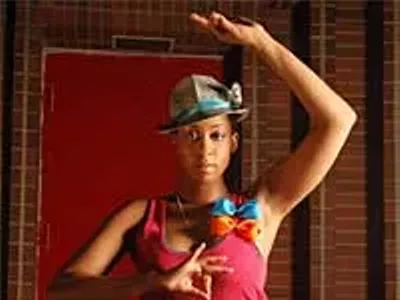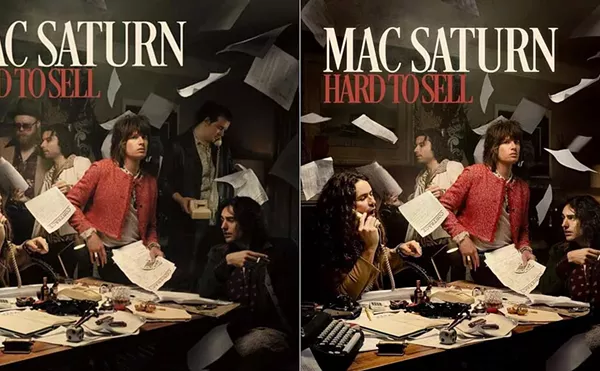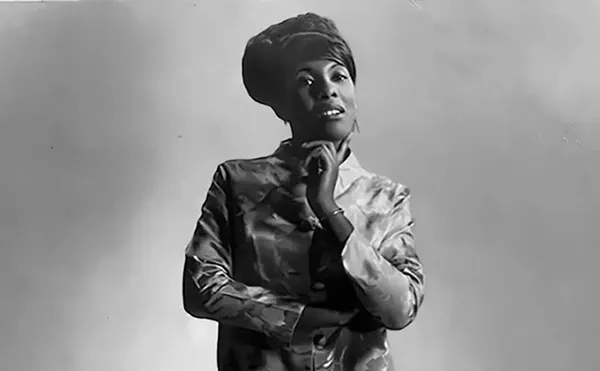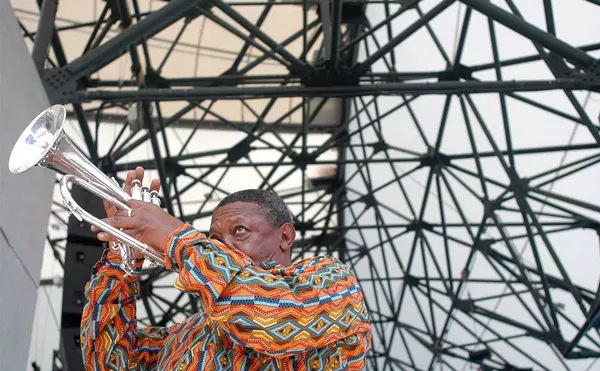
Audio By Carbonatix
[
{
"name": "GPT - Leaderboard - Inline - Content",
"component": "35519556",
"insertPoint": "5th",
"startingPoint": "3",
"requiredCountToDisplay": "3",
"maxInsertions": 100,
"adList": [
{
"adPreset": "LeaderboardInline"
}
]
}
]
In the light, Wolfmother had been gods for a good 60 minutes. But now it’s half a day later, and Stockdale can barely hold his pipe cleaner factory of an Afro aloft, to say nothing of his elongated frame. Estelle’s is lit like the dashboard of a 1977 Mercury Cougar — inky green and orange light seeps from deep porticos, and everyone exists as a denim or leather silhouette. Stockdale’s made this scene his personal pinball machine, bouncing drunkenly off would-be groupies and surly, unsmiling guys alike. That’s until CIV’s "Can’t Wait One Minute More" tears out of the bar’s jukebox. Stockdale suddenly leaps onto our table and executes something that’s Australian for Riverdance before nimbly jumping backward, his brown leather cowboy boots landing square on the floor with a satisfying slap. If you’re the vocalist and guitarist of a hoary, boozy rock band that’s just had its biggest moment in the sun, you might as well get the most out of your license to be a fuck-up.
Of course, the only reason Stockdale was even in Estelle’s was Lollapalooza, and it’s likely, with more than 130 bands in town to perform at the second year of the festival’s Chicago-specific rebirth, that other rockers and various band members repeated his encore performance — it was literally staggering — at lounges and taverns throughout the city. The festival didn’t overtake every cranny. Chicago sprawls too much. But Lolla was definitely a destination event, and for three days the city felt a little like Austin, Texas, during South by Southwest, or the route to Coachella in Indio, Calif.
And that was only in the neighborhoods. Lollapalooza was inescapable downtown, stretching from Monroe Drive on the north nearly to Roosevelt Road on the south, straddling the promenade of Buckingham Fountain, and nestling its side stages, art installations and concession booths into the polite stands of trees that dotted the avenues between the two large fields containing the four main stages. At night massive balloons hovered above Grant Park, illuminating the constant shuffle below with festival branding but also suggesting — in both their magnitude and oddly magical, outsized quality — a little of Chicago’s history. It was like a Midway Plaisance for music fans, with the fountain as its elegant center point. As settings for massive outdoor fests go, it was still hundreds of times more picaresque than the usual jumble of tents, scaffolding and dusty lawns.
Got it bad bad bad
But Lollapalooza was massive, so massive that its promoters — Texas-based Capital Sports & Entertainment — weren’t able to deliver a solid lineup from start to finish. In between stellar sets from the Raconteurs, Ween, Cold War Kids, Wolfmother, Blackalicious, Thievery Corporation, Manu Chao, the Hold Steady, Of Montreal and Queens of the Stone Age were performances that either couldn’t or didn’t live up to the must-attend annual event the festival aspires to be. 30 Seconds to Mars and She Wants Revenge ground the middle of Sunday to a horrifyingly awful stop with sets that aped past trends with opportunistic, unimaginative zeal. Hollow-eyed actor Jared Leto led 30 Seconds through their post-grunge paces, trying to make up for the disconnected emotions in the songs by swearing into the microphone and speaking directly to what must have been street-teamers inserted at the front of the stage. Post-grunge is a strain of music that most people wish would die; the good news is that Leto and 30 Seconds to Mars are out there, doing their part to kill it with a shittiness that’s criminal. As for She Wants Revenge, any of the bands they steal from — Depeche Mode, the Killers, even the Revolting Cocks — would have been a more effective Lolla booking.
Boston’s Dresden Dolls belong in the crap category too. Maybe their alt.cabaret shtick works in a club, but at Lollapalooza they were easily upstaged by the punk rock mimes and clowns who wandered happily through Grant Park all weekend.
As for the rest of the weekend’s misses, it wasn’t the quality that disappointed but the decision to book them in the first place. Despite strong material overall and some great moments within, Feist, the Shins, Andrew Bird and Ben Kweller seemed lost in the giant space of Lollapalooza’s main stages, their performances amounting to background music for Italian beef-eating or skyline-gazing.
Effectively booking such a huge event has to be difficult — everything from sonic strength to genre balance to current popularity has to be accounted for. But it’s worth noting for next year that the best acts brought the volume. St. Louis’ Living Things made noon on a Saturday feel more like Midnight, pounding out gritty Stones grooves and wearing more black clothing and scarves than a Steven Tyler impersonation convention. And the same set Wolfmother performed a few months ago at Small’s was rendered alive and amplified by the enormous outdoor venue. Kids were going bananas in the tightly packed crowd, the band’s big dumb riffs rolling across the bobbling bodies like a sonic time warp from 30-years past. It’s not like every artist has to be loud. L.A. up-and-comers Cold War Kids turned in a riveting set of spare and restless, Spoon-ish pop on one of Lollapalooza’s numerous side stages, and Of Montreal entertained a crowd of kids, moms and neo-hippies with their smart, just barely twee mix of psychedelic weirdness and thrift store pop. But that’s just it — the fest’s bookers should be more cognizant of what’s going to work where and why. A little thoughtfulness will go a long way toward making Lollapalooza the ultimate Midwestern summer destination that it has the potential to be.
New Jack City
The Raconteurs’ Lollapalooza set made quite an impression, even for those that missed it. (Navigating I-94 in the summer is more unnerving than Jared Leto’s narcissism.) The chatter all weekend was about how lively Jack White was and how much better his new band is live, as opposed to the somewhat hurried or even staid sound of their recorded debut. They also covered Gnarls Barkley’s "Crazy," which is some kind of theme. As for Gnarls themselves, the 2006 cultural moment that is "Crazy" came and went in a sweaty anti-climax. On record it’s an intensely sensual experience, its double-skip drum beat and Cee-Lo’s expressive vocal pulling you into the song like nothing since Outkast’s "Hey Ya!" in 2004. Live, however, the experience of 10,000 white people surging toward the stage and singing along was followed immediately by a mass exodus. Maybe they were all heading to the north end of the festival to secure solid seating for Dresden Dolls, but probably not. It’s almost more trouble than it’s worth to have a hit single in what-have-you-done-for-me-lately 2006, as the crowd’s reaction to the rest of Gnarls’ set proved.
So best
On Saturday night there was a choice — Kanye West or Manu Chao? It seemed like everyone was streaming south to witness Kanye’s triumphant homecoming. But once Manu Chao and his band took the stage, what we may have been missing with West was largely forgotten. Leading his economic, but volatile lineup through a tight set of reggae-flavored anthems, Chao sounded like a multi-lingual Rancid, or, more accurately, a similarly joyous devotee of Clash classics like "Tommy Gun" and "London Calling." With the sky streaked a deep red from the setting sun, and the winking windows of the buildings along Michigan Avenue as his footlights, Chao transformed Lollapalooza’s north end into a multinational dance party that still stayed aware of his rails against terrorism and righteous shout-outs for tolerance. It was magic, something completely unique to the moment, and if the festival ever picks up stakes and moves out of Chicago, it’ll never happen again.
Don’t fuck with QOTSA
While the first half of Queens of the Stone Age’s Sunday evening set was generic, livened-up hard blues, Josh Homme and his band turned the rest of it into a particularly searing clinic on how to perform like badasses. Guitar tones sliced through the air like bowie knives meant to slice women’s spaghetti straps — "I hope everyone gets laid tonight," Homme offered at one point, "Most of all, me …" — and the underlying rhythm was its own instrument, hurtling toward each song’s finish and generally making the teeming crowd of mostly shirtless young men act like frat boys on a coke binge. From a crowd perspective, this was as annoying as you’d imagine. But the performance was gripping, and that’s what bands are supposed to turn in at festivals like this. Gutty, evil and shamelessly dirty, QOTSA illustrated how rock music can overtake even the most overbearing of corporate sponsorships. The cheery "Delivered by AT&T" banner that surrounded the stage seemed to cower in fear.
After Queens, Red Hot Chili Peppers took the stage for their festival-closing performance. Dinosaurs from way back when Lollapalooza was only a gleam in Perry Farrell’s eye, RHCP can still make a live show boil with tightly wound energy. It wasn’t Flea’s multicolored Riddler-style unisuit, or Anthony Kiedis’ silky hair and calculated shirt-removal moments. It was the quartet’s sense of themselves as a band, often playing together at the center of the stage, arranged in a loose star shape, Flea slapping away at his bass while John Frusciante played his beat-up Stratocaster like a man possessed. Which, in a way, he is. Frusciante’s struggles with heroin are documented, so when he’s on stage with RHCP, the frailness of his face and body hidden not only by long hair and a baggy suit but his furious, impossibly focused guitar playing, you stop and thank someone that addiction works both ways. The Chili Peppers didn’t play enough of the truly durable hits from their deep catalog, and more than one bass solo is never necessary. But Frusciante even reined in the jamming, and when the onstage camera captured him in close-up, his eyes squeezed shut and a look of rabid concentration on his face, you knew his performance was about joy and pain in competing amounts.
Toward the end of the band’s set, the stage emptied but for Frusciante, who played a brilliant solo version of Simon and Garfunkel’s "For Emily, Whenever I May Find Her." It wasn’t accompanied by any VH1 Storytellers intro. Frusciante didn’t even notice that the majority of the crowd — jackasses seemingly more happy to crowd-surf and mosh lamely than enjoy the set — weren’t even listening. He just played the song, the onstage camera displaying his POV on the enormous big screen, one skinny guy with long hair playing a folk ballad for 30,000 people who didn’t know how good they had it. It was another moment inside a massive weekend of music, and it made everything — Jared Leto, mismatched bookings, outsized sponsorships and almost being kicked in the face by an Afro-headed Australian — more than worth it.
Lollapalooza 2006 Photo Gallery
Photos by Doug Coombe





